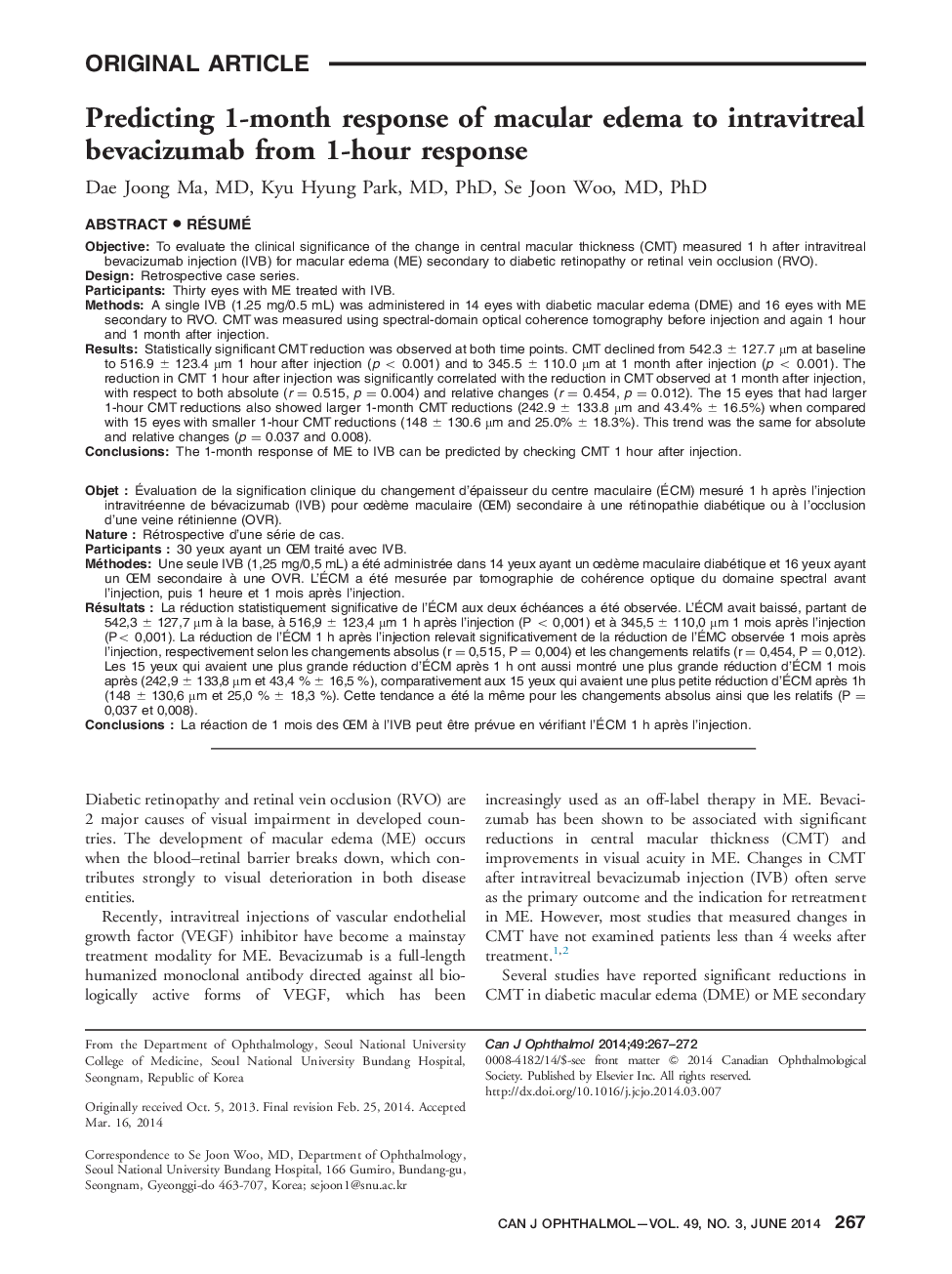| Article ID | Journal | Published Year | Pages | File Type |
|---|---|---|---|---|
| 4009390 | Canadian Journal of Ophthalmology / Journal Canadien d'Ophtalmologie | 2014 | 6 Pages |
ObjectiveTo evaluate the clinical significance of the change in central macular thickness (CMT) measured 1 h after intravitreal bevacizumab injection (IVB) for macular edema (ME) secondary to diabetic retinopathy or retinal vein occlusion (RVO).DesignRetrospective case series.ParticipantsThirty eyes with ME treated with IVB.MethodsA single IVB (1.25 mg/0.5 mL) was administered in 14 eyes with diabetic macular edema (DME) and 16 eyes with ME secondary to RVO. CMT was measured using spectral-domain optical coherence tomography before injection and again 1 hour and 1 month after injection.ResultsStatistically significant CMT reduction was observed at both time points. CMT declined from 542.3 ± 127.7 µm at baseline to 516.9 ± 123.4 µm 1 hour after injection (p < 0.001) and to 345.5 ± 110.0 µm at 1 month after injection (p < 0.001). The reduction in CMT 1 hour after injection was significantly correlated with the reduction in CMT observed at 1 month after injection, with respect to both absolute (r = 0.515, p = 0.004) and relative changes (r = 0.454, p = 0.012). The 15 eyes that had larger 1-hour CMT reductions also showed larger 1-month CMT reductions (242.9 ± 133.8 µm and 43.4% ± 16.5%) when compared with 15 eyes with smaller 1-hour CMT reductions (148 ± 130.6 µm and 25.0% ± 18.3%). This trend was the same for absolute and relative changes (p = 0.037 and 0.008).ConclusionsThe 1-month response of ME to IVB can be predicted by checking CMT 1 hour after injection.
RésuméObjetÉvaluation de la signification clinique du changement d’épaisseur du centre maculaire (ÉCM) mesuré 1 h après l’injection intravitréenne de bévacizumab (IVB) pour œdème maculaire (ŒM) secondaire à une rétinopathie diabétique ou à l’occlusion d’une veine rétinienne (OVR).NatureRétrospective d’une série de cas.Participants30 yeux ayant un ŒM traité avec IVB.MéthodesUne seule IVB (1,25 mg/0,5 mL) a été administrée dans 14 yeux ayant un œdème maculaire diabétique et 16 yeux ayant un ŒM secondaire à une OVR. L’ÉCM a été mesurée par tomographie de cohérence optique du domaine spectral avant l’injection, puis 1 heure et 1 mois après l’injection.RésultatsLa réduction statistiquement significative de l’ÉCM aux deux échéances a été observée. L’ÉCM avait baissé, partant de 542,3 ± 127,7 µm à la base, à 516,9 ± 123,4 µm 1 h après l’injection (P < 0,001) et à 345,5 ± 110,0 µm 1 mois après l’injection (P< 0,001). La réduction de l’ÉCM 1 h après l’injection relevait significativement de la réduction de l’ÉMC observée 1 mois après l’injection, respectivement selon les changements absolus (r = 0,515, P = 0,004) et les changements relatifs (r = 0,454, P = 0,012). Les 15 yeux qui avaient une plus grande réduction d’ÉCM après 1 h ont aussi montré une plus grande réduction d’ÉCM 1 mois après (242,9 ± 133,8 µm et 43,4 % ± 16,5 %), comparativement aux 15 yeux qui avaient une plus petite réduction d’ÉCM après 1h (148 ± 130,6 µm et 25,0 % ± 18,3 %). Cette tendance a été la même pour les changements absolus ainsi que les relatifs (P = 0,037 et 0,008).ConclusionsLa réaction de 1 mois des ŒM à l’IVB peut être prévue en vérifiant l’ÉCM 1 h après l’injection.
